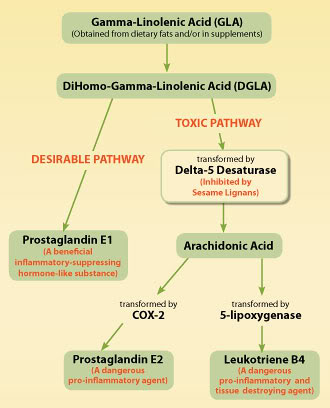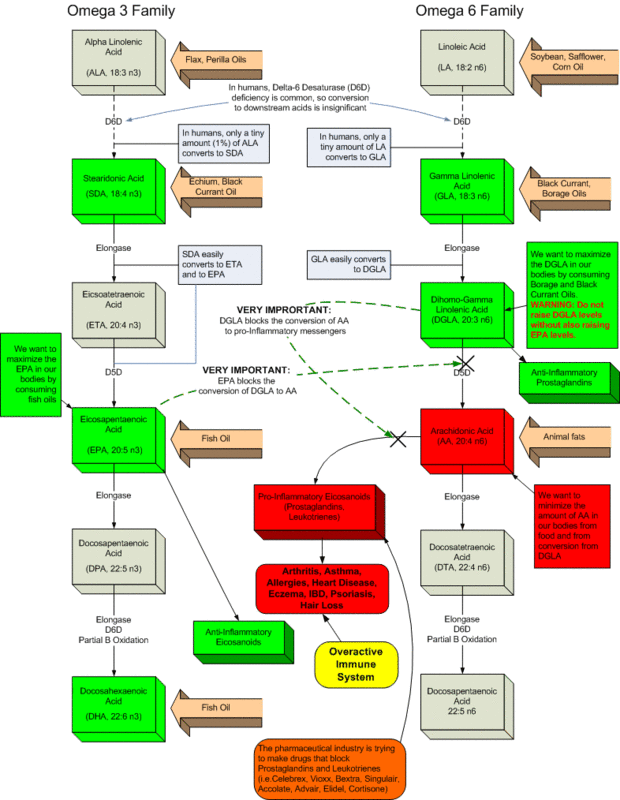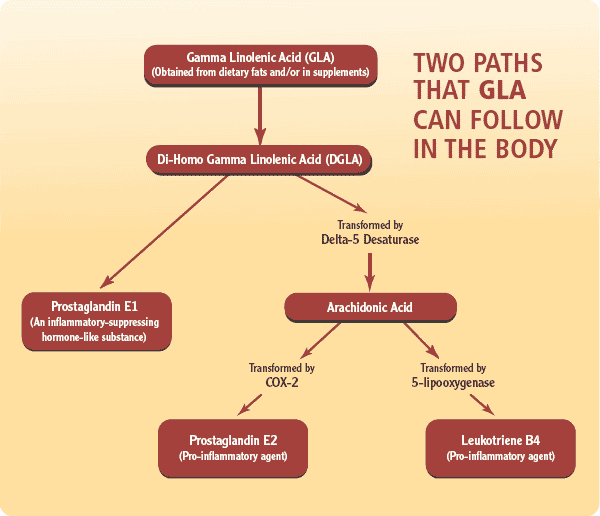A Little Biochemistry
Our body is capable of naturally producing gamma-linolenic acid. In order to do so, it must have linoleic acid (LA) as its starting material. This is an essential fatty acid that our body is unable to make and we must ingest as part of our everyday diet. Fortunately, we get plenty of linoleic acid in our daily diet since it is commonly found in almost all edible vegetable oils. Once linoleic acid is ingested, it is acted upon by an enzyme called Delta-6- Desaturase (D6D) which biochemically converts LA into GLA . This is how we normally get our daily fix of GLA. Note the importance of the enzyme D6D - without it we would be deficient in GLA no matter how much linoleic acid we get in our diets. GLA is further converted, via a sequence of biochemical steps, into a very important compound called prostaglandin 1 (PG1), a key molecule for maintaining healthy skin. PG1 exhibits a potent anti-inflammatory effect on the skin and also is very effective in regulating water loss and protecting skin from injury and damage (2).
The D6D enzyme is often referred to as a "lazy" enzyme. That is to say, it can be slow in doing its job, and under some conditions may actually be impaired. People with skin disorders such as eczema, atopic dermatitis, and psoriasis show increased levels of linoleic acid with a simultaneous decrease in gamma-linolenic acid (3). This evidence strongly suggests a reduction in the activity of the D6D enzyme. As a consequence, the resulting decrease in the synthesis of PG1 may be responsible for the characteristic dry skin and transepidermal water loss observed in these people. It is here that the importance of borage oil with its rich source of gamma-linolenic acid becomes evident. Used as a dietary supplement or even applied topically, borage oil can circumvent a "lazy" or impaired D6D enzyme by supplying the body directly with GLA and thus allowing the production of normal levels of PG1.
Borage Oil in your Diet and on your Skin
Several recent studies indicate that borage oil taken orally increases PG1 levels in the skin and suppresses chronic inflammation (4,5,6,7). Evidence from animal studies indicates that skin disorders associated with fatty acid imbalances can be corrected through dietary inclusion of borage oil. Similar research with humans has confirmed these findings (8,9). In fact, a recent study (10) has shown that dietary supplementation of borage oil for patients with skin disorders can result in direct improvement in the condition of their skin.
Not only is borage oil excellent for your skin when taken internally, but there is also more than enough evidence showing that, when applied topically to your skin, borage oil has the same positive effects on clearing up various skin disorders (11,12).
A very interesting experiment measured the effects of skin creams containing borage oil on dry or damaged skin (13). Twenty healthy subjects who had either dry (but otherwise normal skin) or had surfactant induced dry, scaly skin were tested over 14 days. Results indicated that the cream containing the borage oil was superior in restoring moisture and smoothness to both the dry skin as well as the surfactant damaged skin. This experiment was interpreted as strong evidence that borage oil plays an important role in restoring the intracellular moisture barrier of adult skin which is either chronically dry or has been environmentally damaged.
Babies and Borage Oil
One of the more powerful demonstrations of the benefits to the skin of topically applied borage oil is a clinical study (14) done on 48 infants suffering from severe infantile seborrhoic dermatitis, a common condition in infants known as "cradle cap." This condition is characterized by dry scales and crusts on the scalp, eyelids, face, armpits, breast and groin. The infants were treated twice daily with topically applied borage oil and the condition cleared within two weeks. Not only was there improvement in the areas where the borage oil was directly applied, but also in the areas where it was not. This result indicated that the borage oil was effectively absorbed through the skin and became available throughout the body as a source of gamma-linolenic acid for the biosynthesis of Prostaglandin 1. If the treatment was discontinued, the symptoms came back within 1 week. However, if the treatment was maintained until the infants became 7 months old and was then stopped, there was no relapse.
The authors hypothesized that these infants were born with an immature D6D enzyme system and were unable to produce sufficient gamma-linolenic acid on their own, thus giving rise to the symptoms of "cradle cap". The borage oil treatment corrected the symptoms by supplying GLA until the infant's own enzyme system caught up.
Conclusions
There is ample evidence from research on both humans and animals showing that borage oil has a significant effect on improving the health and appearance of skin tissue. Clinically, borage oil has been shown to be a very effective agent for treating skin disorders and for alleviating the inflammatory symptoms associated with these disorders. For everyday use, borage oil has been shown to be very effective in treating the redness, inflammation, and moisture loss associated with dry skin.
Whether you take borage oil orally or apply it to your skin, it appears to positively affect the texture, suppleness and moisture content of skin.
Simply put, borage oil is good for your skin.
BUY THESE PRODUCTS
References
Grieve, M., A Modern Herbal (Vol 1) Dover Publications, NY 1971 p.119.
2. Ziboh, V and Miller, C. 1990. "Essential fatty acids and polyunsaturated fatty acids: Significance in Cutaneous Biology". Annu. Rev. Nutr. 10:433.
Melnick, B and Plewig, G. 1991. "Atopic Dermatitis and Disturbances in Essential Fatty Acid and Prostaglandin E Metabolism" J. Amer. Acad. Dermatol 25:859.
Iverson, L., Fogh, K., and Kragballe, K. 1992. "Effects of Dihomo gamma Linolenic Acid and 15-lipoxygenase Metabolite on Eicosanoid Metabolism by Human Mononuclear Leukocytes in vitro: Selective Inhibition of the 15-lipoxygenase Pathway" Arch. Dermatol. Res. 284:222.
Miller, C., Ziboh, V., Wong, T., and Fletcher, M. 1990. "Dietary Supplementation with Oils Rich in (n-3) and (n-6) Fatty Acids Influences in vivo Levels of Epidermal Lipoxygenase Products in Guinea Pigs". Lipids. 120:36.
Bauer, P.M., Van de Kerkhof, P.C.M., and Maassen de Grood, R. 1986. "Epidermal Hyperfroliferation Following Induction of Microabscesses of Leukotriene" B4. Br. J. Dermatol. 114:409.
Tate, G., Mandell, B.F., Laposata, D., Ohliger, D., Baker, D.G., Schumacher, H.T. and Zurier, R.B. 1989. "Suppression of Acute and Chronic Inflammation by Dietary gamma-Linolenic Acid". J. Rheumatol. 16:729.
Ziboh, V.A. and Fletcher, M. 1992. "Dose-Response Effects of Dietary gamma-Linolenic Acid Enriched Oils on Human Polymorphonuclear - Neutrophil Biosynthesis of Leukotriene" B4. Amer. J.Clin. Nutr. 55:39.
Ziboh, V.A. 1995. "The Biological / Nutritional Significance of gamma- Linolenic Acid in the Epidermal Metabolism and Generation of Potent Biological Modulations". Inform. 6;4:519.
Bahmer, F.A. and Schafer, J. 1992. "Treatment of Atopic Dermatitis with Borage Oil (Glandol) - A Time Series Analysis Study". Aktuel. Dermatol. 18:385.
Diezel, W.E., Schulz, E., Skanks, M. and Heise, H. 1993. "Plant Oils: Topical Application and Anti-Inflammatory Effects (croton oil test)". Dermatol. Monatsschr. 179:173.
Elias, P. 1993. as quoted in: R.L. Goldberg. "The Compounder's Corner: Exotic Claims". Drug and Cosmetic Ind. Jan., p.40.
Nissen, H.P., Blitz, H., and Muggli, R. 1995. "The effects of gamma-Linolenic Acid on Skin Smoothness, Humidity and TEWL - A Clinical Study". Inform. 6;4:519.
Tolleson, A., and Frithz, A 1993. "Borage Oil: An Effective New Treatment for Infantile Seborrhoic Dermatitis". Brit. J. Dermatol. 129:95



